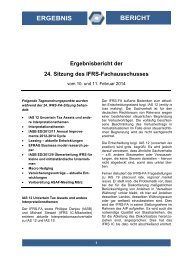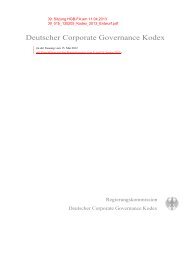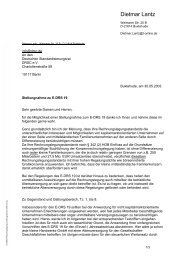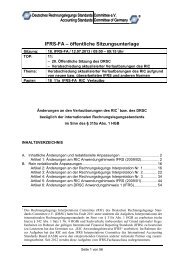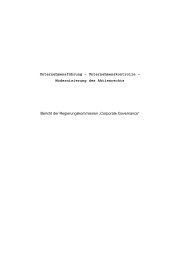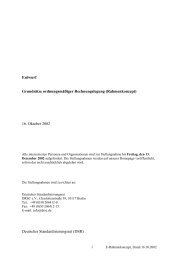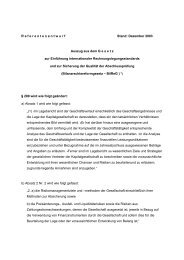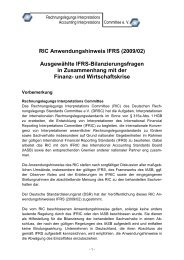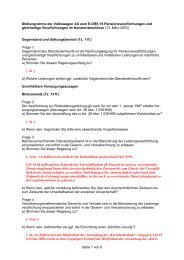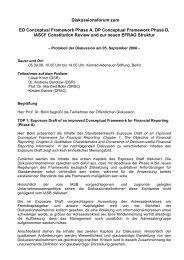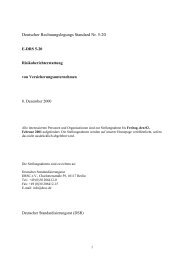Classification and Measurement: Limited Amendments to IFRS 9
Classification and Measurement: Limited Amendments to IFRS 9
Classification and Measurement: Limited Amendments to IFRS 9
Create successful ePaper yourself
Turn your PDF publications into a flip-book with our unique Google optimized e-Paper software.
CLASSIFICATION AND MEASUREMENT: LIMITED AMENDMENTS TO <strong>IFRS</strong> 9 (PROPOSED AMENDMENTS TO <strong>IFRS</strong> 9 (2010))<br />
demonstrates that its performance is evaluated on a fair value basis a <strong>to</strong>tal<br />
return basis, no further documentation is required <strong>to</strong> demonstrate compliance<br />
with paragraph 4.2.2(b).<br />
Paragraph B4.3.1 is amended. New text is underlined.<br />
Embedded derivatives (section 4.3)<br />
B4.3.1 When an entity becomes a party <strong>to</strong> a hybrid contract with a host that is not an<br />
asset within the scope of this <strong>IFRS</strong>, paragraph 4.3.3 requires the entity <strong>to</strong> identify<br />
any embedded derivative, assess whether it is required <strong>to</strong> be separated from the<br />
host contract <strong>and</strong>, for those that are required <strong>to</strong> be separated, measure the<br />
derivatives at fair value at initial recognition <strong>and</strong> subsequently at fair value<br />
through profit or loss.<br />
The heading before paragraph B4.4.1 is amended. Deleted text is struck through.<br />
Paragraph B4.4.1 is included for reference only <strong>and</strong> is not proposed for amendment.<br />
Reclassification of financial assets (section 4.4)<br />
B4.4.1 Paragraph 4.4.1 requires an entity <strong>to</strong> reclassify financial assets if the objective of<br />
the entity’s business model for managing those financial assets changes. Such<br />
changes are expected <strong>to</strong> be very infrequent. Such changes must be determined<br />
by the entity’s senior management as a result of external or internal changes<br />
<strong>and</strong> must be significant <strong>to</strong> the entity’s operations <strong>and</strong> demonstrable <strong>to</strong> external<br />
parties. Examples of a change in business model include the following:<br />
Paragraph B5.1.1 is amended. New text is underlined.<br />
<strong>Measurement</strong> (chapter 5)<br />
Initial measurement (section 5.1)<br />
B5.1.1 The fair value of a financial instrument at initial recognition is normally the<br />
transaction price (ie the fair value of the consideration given or received, see also<br />
paragraph B5.1.2A <strong>and</strong> <strong>IFRS</strong> 13). However, if part of the consideration given or<br />
received is for something other than the financial instrument, an entity shall<br />
measure the fair value of the financial instrument <strong>and</strong> classify the financial<br />
instrument in accordance with paragraph 4.1.1. For example, the fair value of a<br />
long-term loan or receivable that carries no interest can be measured as the<br />
present value of all future cash receipts discounted using the prevailing market<br />
rate(s) of interest for a similar instrument (similar as <strong>to</strong> currency, term, type of<br />
interest rate <strong>and</strong> other fac<strong>to</strong>rs) with a similar credit rating. Any additional<br />
amount lent is an expense or a reduction of income unless it qualifies for<br />
recognition as some other type of asset.<br />
31<br />
� <strong>IFRS</strong> Foundation



